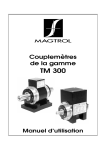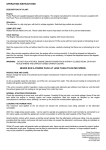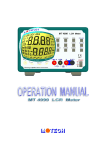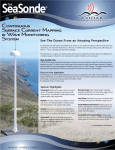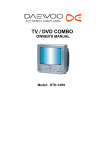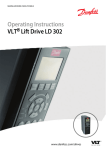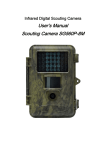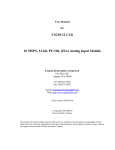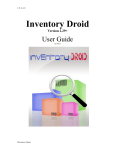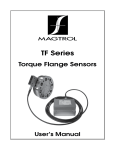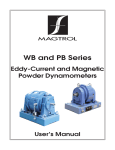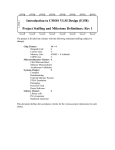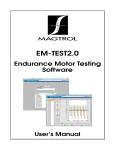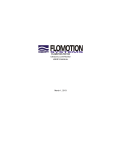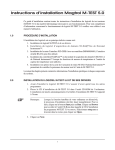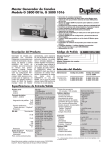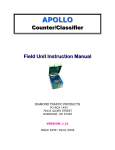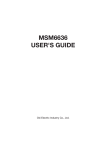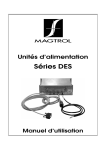Download TM Series Product User`s Manual
Transcript
TM 300 Series In-Line Torque Transducers User’s Manual Purchase Record Please record all model numbers and serial numbers of your Magtrol equipment, along with the general purchase information. The model number and serial number can be found on either a silver identification plate or white label affixed to each unit. Refer to these numbers whenever you communicate with a Magtrol representative about this equipment. Model Number: _____________________________ Serial Number: _____________________________ Purchase Date: _____________________________ Purchased From: _____________________________ While every precaution has been exercised in the compilation of this document to ensure the accuracy of its contents, Magtrol, Inc./Magtrol SA assumes no responsibility for errors or omissions. Additionally, no liability is assumed for any damages that may result from the use of the information contained within this publication. Copyright Copyright ©2006–2008 Magtrol, Inc. All rights reserved. Copying or reproduction of all or any part of the contents of this manual without the express permission of Magtrol is strictly prohibited. Trademarks LabVIEW™ is a trademark of National Instruments Corporation. Microsoft® is a registered trademark of Microsoft Corporation. National Instruments™ is a trademark of National Instruments Corporation. Windows® is a registered trademark of Microsoft Corporation. 1st English Edition, rev. G– June 2011 Safety Precautions Warning! In order to minimize risks, it is of utmost importance to respect the current safety standards when planning, configuring and operating the Torque measurement drive train. 1. Make sure that all Magtrol electronic products are earth-grounded, to ensure personal safety and proper operation. 2. Check line voltage before operating electronic equipment. 3. Make sure that all rotating parts are equipped with appropriate safety guards. Note: 4. 5. 6. 7. Detailed information regarding safety guards can be found in Section 2.5 – Protective Systems. Periodically check all connections and attachments. Always wear protective glasses when working with rotating elements. Never wear a necktie or baggy clothes when standing close to rotating elements. Never stand too close or bend over the rotating drive chain. i Revisions to this Manual The contents of this manual is subject to change without prior notice. Should revisions be necessary, updates to all Magtrol User’s Manuals can be found at Magtrol’s website at www.magtrol.com/support/manuals.htm?tab=1#TabbedPanels1. Please compare the date of this manual with the revision date on the web site, then refer to the manual’s Table of Revisions for any changes/updates that have been made since this edition. Revision Date First English edition, revision G – June 2011 Date 20.06.11 Edition 1st Edition - rev. G Change Accuracy update for TMB 301 to 313 26.05.11 04.10.10 28.07.09 10.09.08 1st Edition - rev. F 1st Edition - rev. E 1st Edition - rev. D 1st Edition - rev. C Overload limit updated Added information regarding vertical installation of a TM/TMB Added information regarding connection to an differential amplifier Updated: Figure 2–3 Parastic Forces 12.18.07 1st Edition - rev. B New transducer model: TM 309 01.10.07 1st Edition - rev. A Added information regarding connection to non-Magtrol electronics. ii Section(s) 1.3.1, 1.3.2 1.3.1, 1.3.2, 1.3.3 2.1.3 2.7.3 2.2 1.3.2, 2.2.1, 2.2.2 and 2.4.3 2.7.3 Table of Contents Safety Precautions..........................................................................................................................i Revisions to this Manual................................................................................................................ii Revision Date..................................................................................................................................................................ii Table of Revisions.......................................................................................................................................................ii Table of Contents...........................................................................................................................iii Table Of Figures......................................................................................................................................................... iv Preface................................................................................................................................................. v Purpose of this manual.......................................................................................................................................... v Who should use this manual............................................................................................................................... v Manual Organization.............................................................................................................................................. v 1. Introduction..................................................................................................................................1 1.1 General information......................................................................................................................................... 1 1.2 Description.............................................................................................................................................................. 1 1.3 Data Sheets.............................................................................................................................................................. 2 1.3.1 TM 301 – TM 308............................................................................................................................................ 2 1.3.2 TM 309 – TM 313............................................................................................................................................ 6 1.3.3 TM 314 – TM 317.......................................................................................................................................... 12 2. Installation / Configuration.................................................................................................17 2.1 Mounting possibilities.................................................................................................................................... 17 2.1.1 Suspended Installation................................................................................................................................... 17 2.1.2 Supported Installation.................................................................................................................................... 17 2.1.3 TM/TMB in Vertical Installation.................................................................................................................... 18 2.2 Parasitic forces.................................................................................................................................................. 18 2.2.1 Radial Forces (Bending)................................................................................................................................ 19 2.2.2 Axial Forces (Thrust)..................................................................................................................................... 20 2.3measuring shaft vibrations........................................................................................................................ 21 2.3.1 Permitted Vibrations on Measuring Shaft...................................................................................................... 21 2.3.2 Torque Signal Conditioning Electronic Circuit.............................................................................................. 23 2.4 Mounting limits.................................................................................................................................................. 24 2.4.1 Dynamic Torque............................................................................................................................................. 24 2.4.2 Natural Frequency of Drive Train.................................................................................................................. 24 2.4.3 Natural Measuring Shaft Torsional Frequency.............................................................................................. 26 2.4.4 Maximum Dynamic Amplitude..................................................................................................................... 27 2.5 Protective Systems........................................................................................................................................... 27 2.6 Electronic signal processing..................................................................................................................... 29 2.6.1 Model 3410 Torque Display........................................................................................................................... 29 2.6.2 Model 6400 Torque Transducer Display........................................................................................................ 30 2.6.3 Model DSP6001 Programmable Dynamometer Controller........................................................................... 31 2.7 Electrical connections................................................................................................................................ 32 2.7.1 Grounding...................................................................................................................................................... 32 2.7.2 Connecting Cable........................................................................................................................................... 33 2.7.3 Connection to Non-Magtrol Electronics........................................................................................................ 34 3. Operating Principles................................................................................................................36 3.1 Torque Transducer Architecture........................................................................................................... 36 iii Table of Contents Magtrol TM Series In-Line Torque Transducers 3.1.1 Differential Transformer................................................................................................................................ 37 3.2 Speed conditioning chain.............................................................................................................................. 37 3.3Built-in self-test circuit............................................................................................................................... 37 4. Maintenance / Repair.................................................................................................................38 4.1 Maintenance......................................................................................................................................................... 38 4.2 Repair........................................................................................................................................................................ 39 Service Information.......................................................................................................................40 Returning Magtrol equipment for Repair and/or Calibration...................................................... 40 Returning Equipment to Magtrol, Inc. (United States)................................................................................................ 40 Returning Equipment to Magtrol SA (Switzerland)..................................................................................................... 40 Table Of Figures 1. Introduction Figure 1–1 TMB 313 In-Line Torque Transducer........................................................................................................1 2. Installation / Configuration Figure 2–1 Suspended Installation............................................................................................................................17 Figure 2–2 Supported Installation.............................................................................................................................18 Figure 2–3 Parasitic Forces.......................................................................................................................................18 Figure 2–4 Radial Displacement...............................................................................................................................21 Figure 2–5 Vibratory Acceleration.............................................................................................................................22 Figure 2–6 SW1 – SW12 Micro-switches and Offset Adjustment Potentiometer.......................................................23 Figure 2–7 Simplified Drive Train Model..................................................................................................................24 Figure 2–8 Frequency Response Graph.....................................................................................................................25 Figure 2–9 Admissible Dynamic Load.......................................................................................................................27 Figure 2–10 Example of Protective System...............................................................................................................28 Figure 2–11 Model 3410 Torque Display..................................................................................................................29 Figure 2–12 PC-Based System Configuration with Model 3410 Display..................................................................29 Figure 2–13 Model 6400 Torque Transducer Display...............................................................................................30 Figure 2–14 PC-Based System Configuration with Model 6400 Display..................................................................30 Figure 2–15 Model DSP6001 Programmable Dynamometer Controller..................................................................31 Figure 2–16 PC-Based System Configuration with Model DSP6001 Controller......................................................31 Figure 2–17 Common Grounding..............................................................................................................................32 Figure 2–18 6-pin Souriau Connector Configuration................................................................................................33 Figure 2–19 14-pin Centronics Connector Configuration.........................................................................................33 Figure 2–20 Wiring Diagram for Connection to Non-Magtrol Electronics...............................................................34 Figure 2-21 ER 107 Pin Configuration......................................................................................................................35 3. Operating Principles Figure 3–1 TM Torque Transducer Principal Elements.............................................................................................36 iv Preface Purpose of this manual This manual contains information required for the installation and general use of Magtrol’s TM Series In-Line Torque Transducers. To achieve maximum capability and ensure proper use, please read this manual in its entirety before operating the unit. Keep the manual in a safe place for quick reference whenever a question should arise. Who should use this manual This is written for operators installing a torque transducer as part of a test system that meausres the torque on transmission chains. The operator is assumed to have the necessary technical training in electronics and mechanical engineering enabling him to install the in-line torque transducer without risk. Manual Organization This section gives an overview of the structure of the manual and the information contained therein. Some information has been deliberately repeated in different sections of the document to minimize cross-referencing and to facilitate understanding through reiteration. The structure of the manual is as follows: Chapter 1 : Introduction – Contains the technical data sheets for Magtrol’s TM In‑Line Torque Transducers, which describe the units and provide detailed technical characteristics. Chapter 2 : Installation / Configuration – Provides information needed for the setup of the TM Transducers in a test system, and their integration with Magtrol electronic control units. Chapter 3 : Operating principles – Information pertaining to theory of operation including details about the transducer's architecture, speed conditioning chain and built-in self-test circuit. Chapter 4 : MAINTENANCE / REPAIR – Provides information on maintenance and repair procedures, should the need arise. v Preface Magtrol TM Series In-Line Torque Transducers Conventions used in this manual The following symbols and type styles may be used in this manual to highlight certain parts of the text: Note: Caution : This is intended to draw the operator’s attention to complementary information or advice relating to the subject being treated. It introduces information enabling the correct and optimal functioning of the product to be obtained. This is used to draw the operator's attention to information, directives, procedures, etc. which, if ignored, may result in damage being caused to the material being used. The associated text describes the necessary precautions to take and the consequences that may arise if the precautions are ignored. Warning! THIS INTRODUCES DIRECTIVES, PROCEDURES, PRECAUTIONARY MEASURES, ETC. WHICH MUST BE EXECUTED OR FOLLOWED WITH THE UTMOST CARE AND ATTENTION, OTHERWISE THE PERSONAL SAFETY OF THE OPERATOR OR THIRD Parties MAY BE PUT AT RISK. THE READER MUST ABSOLUTELY TAKE NOTE OF THE ACCOMPANYING TEXT, AND ACT UPON IT, BEFORE PROCEEDING FURTHER. vi 1. Introduction 1.1 General information The TM Series In-Line Torque Transducers represent the new generation of high-precision torque sensors with integrated electronic processing circuitry developed by Magtrol. The TM Series transducers are available in three versions: TMB, TM and TMHS. TMB for all standard applications, TM for high-precision applications and TMHS for high-speed applications. The TM 300 Series includes transducers with the following torque ratings: 0.1 N·m, 0.2 N·m, 0.5 N·m, 1 N·m, 2 N·m, 5 N·m, 10 N·m, 20 N·m, 50 N·m, 100 N·m, 200 N·m, 500 N·m, 1 000 N·m, 2 000 N·m, 5 000 N·m and 10 000 N·m. The TM Series In-Line Transducers, together with Magtrol's New TF Series Torque Flange Transducers, offer a wide range of torque measurement requirements for the most demanding applications. 1.2 Description All TM Series In-Line Torque Transducers consist of a torque measuring shaft and built-in signal processing electronics. These elements, along with two sealed bearings having lifelong lubrication, are all contained in an aluminium housing which also supports the shaft. The upper part of the unit contains the built-in electronics. This part is sealed according to the IP44 standard and offers protection against splashed water. A Souriau connector allows the torque transducer to be connected to an external signal processing unit—such as the Magtrol 3410 Torque Display—via a special cable assembly. Figure 1–1 TMB 313 In-Line Torque Transducer TM Torque Transducers perform the following main functions: 1. Measurement of static and dynamic torque and detection of torque direction. 2. Measurement of the shaft's rotational speed and detection of rotational direction. 3. Self-check. The transducer's integrated electronic circuitry filters the torque signal and its built-in self-test function checks the operation of the measuring chain. Each transducer also has a built-in temperature compensation circuit. This assures that the accuracy of the measured torque is maintained regardless of operating temperature. 1 Chapter 1 – Introduction 1.3 Data Sheets 1.3.1 TM 301 – TM 308 Magtrol TM Series In-Line Torque Transducers TM 301 – TM 308 Data Sheet TM 301 – TM 308 In-Line Torque Transducers Features • • • • • • • • • • • • • • • IntegratedTorqueandSpeedConditioning TorqueRange:0.1N·mto20N·m(0.07lb·ftto15lb·ft) Accuracy:<0.1% OverloadCapacity:200% OverloadLimit:400% HighSpeedApplications:upto50,000rpm Non-Contact(nosliprings) NoElectronicComponentsinRotation HighElectricalNoiseImmunity SingleDCPowerSupply:20VDCto32VDC ImmediateSpeedDetection AdjustableTorqueSignalFrequencyLimitation Built-inTestFunction StainlessSteelShaft EMCSusceptibilityConformstoEuropeanStandards Model TM 307 Torque Transducer Description Magtrol’s In-Line Torque Transducers provide extremely accuratetorqueandspeedmeasurementoveraverybroadrange. Eachmodelhasanintegratedconditioningelectronicmodule providinga0to±10VDCtorqueoutputandanopencollector speedoutput.MagtrolTorqueTransducersareveryreliable, providinghighoverloadprotection,excellentlongtermstability andhighnoiseimmunity. All transducer models employ our unique non-contact differential transformer torque measuring technology. This measuringtechnologyoffersmanybenefits,mostnotablythat noelectroniccomponentsrotateduringoperation. Toprovidecustomerswithseveralprice/performanceoptions, Magtroloffersthreetorquetransducermodels:basicaccuracy (TMBseries),highaccuracy(TMseries)andhighspeedwith highaccuracy(TMHS). Eachtransducerconsistsofahardenedstainlesssteelshaftwith smoothshaftends,ananodizedaluminiumhousingcontaining theguidebearingsandanelectronicmeasurementconditioner. Theintegratedelectroniccircuit,suppliedbysingleDCvoltage, provides torque and speed signals without any additional amplifier.Connectionsaremadebymeansofa6-polemale connector mounted on the housing, and fixed mounting is enabledbymountingholeslocatedonthetransducer. applications TM, TMB and TMHS Series Torque Transducers provide dynamictorqueandspeedmeasurementof: • Propellers-aerospace,marineandhelicopter • Windshieldwipers,electricalwindows,starters, generatorsandbrakesinautomobileindustry • Pumps-waterandoil • Reductiongearsandgearboxes • Clutches • Motorizedvalves • Drills,pneumatictoolsandothermachinetools Basic system conFiguration TORQUE TRANSDUCER TM 301 – TM 308 1 Power Supply 20 to 32 VDC / 100 mA max. Test Torque 0 to ±10 VDC (max.) Speed 2 www.magtrol.com Chapter 1 – Introduction Magtrol TM Series In-Line Torque Transducers Specifications TM 301 – TM 308 moDel ratings TheratingsinthefollowingtableapplytoallTorqueTransducerseries(TM,TMHSandTMB). Nominal Rated Torque Torsional Stiffness N·m lb·ft N·m/rad lb·ft/rad 301 * 0.1 0.07 29 21 302 * 0.2 0.15 29 21 303 0.5 0.37 66 48 304 1 0.7 145 107 305 2 1.5 290 214 306 5 3.7 725 535 307 10 7.4 1450 1069 308 20 15 2900 2139 * Models 301 and 302 available in TM Series only. Model Moment of Inertia kg·m² lb·ft·s² 2.50 × 10-5 1.84 × 10-5 2.50 × 10-5 1.84 × 10-5 2.55 × 10-5 1.88 × 10-5 2.82 × 10-5 2.07 × 10-5 2.91 × 10-5 2.14 × 10-5 3.08 × 10-5 2.27 × 10-5 2.63 × 10-5 1.94 × 10-5 2.66 × 10-5 1.96 × 10-5 Weight kg lb 1.1 2.43 1.1 2.43 1.1 2.43 1.2 2.65 1.2 2.65 1.2 2.65 1.2 2.65 1.2 2.65 series ratings TheratingsinthefollowingtableapplytoallstandardTorqueTransducermodels301–308,unlessotherwisenoted. Standard Version TM Series TMHS Series TMB Series TORQUE MEASUREMENT Rated Torque (RT) 0 to ±100% of RT Maximum Dynamic Torque Peak Value 0 to ±200% of RT (Overload Capacity) Maximum Dynamic Torque Without Damage 0 to ±400% of RT (Overload Limit) Combined Error of Linearity and < ±0.1% of RT Hysteresis < ±0.1% of RT < ±0.1% of RT (0.2% for TM 301) to 100% of RT < ±0.1% of Combined Error of Linearity and < ±0.15% of < ±0.1% of measured value Hysteresis from 100% to 200% of RT measured value measured value (0.2% for TM 301) Temperature Influence on the Zero/ Sensitivity: • In the Compensated Range +10 °C to +60 °C < ±0.1% of RT/10K < ±0.2% of RT/10K • In the Compensated Range -25 °C to +80 °C < ±0.2% of RT/10K < ±0.4% of RT/10K Influence of Speed on the Zero Torque < ±0.01% of RT/1000 rpm < ±0.02% of RT/1000 rpm Signal Long-term Stability of Sensitivity < ±0.05% of RT/year < ±0.1% of RT/year SPEED MEASUREMENT TMHS 303: 1 to 40,000 rpm Rated Range of Use 1 to 20,000 rpm 1 to 6,000 rpm TMHS 304-308: 1 to 50,000 rpm Number of Teeth 60 Z Minimum Speed Detection 1 rpm ENVIRONMENT Storage Temperature Range -40 °C to +100 °C Operating Temperature Range -40 °C to +85 °C Mechanical Shock according to IEC 68.2.27 / Class D3 Vibration according to IEC 68.2.6 / Class D3 Protection Class IP 44 MECHANICAL CHARACTERISTICS Shaft Ends smooth G2.5 according to Balancing Quality G1 according to ISO 1940 ISO 1940 INPUT AND OUTPUT SIGNALS Power Supply (max. voltage / current) 20 to 32 VDC / 100 mA Torque Output (rated / max.) ±5 / ±10 VDC Filter Cutoff (frequency) 5000, 2500, 1000, 500, 200, 100, 40, 20, 10, 5, 2, 1 Hz Speed Output (frequency) open collector (15 Ω in series), max. 30 VDC, protected against short-circuits CONNECTORS Counter Connector (female) optional (P/N 957.11.08.0081) 2 3 Chapter 1 – Introduction Magtrol TM Series In-Line Torque Transducers Specifications TM 301 – TM 308 operating principles Themeasuringsystem,basedontheprincipleofavariable, torque-proportional transformer coupling, consists of two concentriccylindersshrunkontheshaftoneachsideofthe shaft’sdeformationzone,andtwoconcentriccoilsattached tothehousing. overlap.Thusatorque-proportionalvoltageisonthesecondary coil.Theconditioningelectroniccircuitincorporatedinthe transducer converts the voltage to a nominal torque signal of0to±5VDC.Alow-passfilter(Butterworth/2ndorder), adjustablefrom5kHzto1Hz,allowstuningofthetorque signalfrequencylimitation. Bothcylindershaveacircularlydisposedcoincidingrowof slotsandrotatewiththeshaftinsidethecoils.Analternating currentwiththefrequencyof20kHzflowsthroughtheprimary coil.Whennotorqueisapplied,theslotsonthetwocylinders failtooverlap.Whentorqueisapplied,thedeformationzone undergoes an angular deformation and the slots begin to Anopticalsensorreadsthespeedonatoothedpathmachined directlyonthemeasuringsystem.Theelectronicconditioner outputsafrequencysignalproportionaltotheshaftrotational speed.Anactivecircuitcompensatesthezeroandsensitivity temperaturedriftswithinatoleranceof0.1%/10K. Dimensions M F D C J 60° H TM 301–303 Shaft Detail A N P N K G A F E F D R Q B C S CAUTION! E D C B CC L T ROTATING PARTS IN OPERATION. STOP SYSTEM BEFORE PERFORMING MAINTENANCE. 60° AA DD U V W EE Y X Permitted Axial Thrust GG FF NOTE: Dimensions are the same for every series (TM, TMHS, TMB). Original dimensions are in Metric units. Dimensions converted to English have been rounded up to 3 or 4 decimal places. Model 301–303 304–308 Model 301–303 units mm ØB ØC ØD 42g6 2.12 0.1 1.6533 0.083 0.004 in 2.362 1.6526 60 42g6 6.7 4.3 mm 1.6533 0.264 0.169 in 2.362 1.6526 units mm in mm 304–308 3 in ØA 60 R 14 S 12 0.551 0.472 22 20 0.866 0.787 E --- F 1.9 G --- H --- --- 0.075 --- --- M4 3.2 10 14 J 13.2 K 7.8 L 5 M 114 N 60 P Q 5 9 0.520 0.307 0.197 4.488 2.362 0.197 0.354 21.2 10.8 5 136 60 5 12 M4 0.126 0.394 0.551 0.835 0.425 0.197 5.354 2.362 0.197 0.472 ØT U V 6h6 15 10 0.2362 0.591 0.394 0.2359 10h6 15 10 0.3937 0.591 0.394 0.3933 W M5 X 7.5 CC DD 0 87 35 (-0.05 ) 1.3779 M5 0.295 1.772 3.937 3.425 1.3760 0 M5 7.5 45 100 87 35 (-0.05 ) 1.3779 M5 0.295 1.772 3.937 3.425 1.3760 4 Y 45 AA 100 EE 30 FF 7.5 GG 45 1.181 0.295 1.772 30 ±0.02 7.5 45 1.1819 0.295 1.772 1.1803 Chapter 1 – Introduction Magtrol TM Series In-Line Torque Transducers Specifications TM 301 – TM 308 system options anD accessories TM SERIES TORQUE TRANSDUCER Unit Under Test A F E B C D PC CAUTION! ROTATING PARTS IN OPERATION. STOP SYSTEM BEFORE PERFORMING MAINTENANCE. Coupling Torque 1.0 Software Coupling Supported Installation Mandatory for high speed applications. TM Series Torque Transducer SPEED TARE RS-232C SELECT TM SERIES TORQUE TRANSDUCER SYSTEM TORQUE Unit Under Test TRANSDUCER MAGTROL ROTATING PARTS IN OPERATION. STOP SYSTEM BEFORE PERFORMING MAINTENANCE. Model 3410 Torque Display CAUTION! D C E F A B Coupling Coupling Suspended Installation For low speed applications only, uses single-element couplings to create a shorter drive train. PC-Based System Configuration Torque Transducer with Model 3410 Display and Torque 1.0 Software Couplings Torque Transducer Displays WhenMagtrolTMB,TMandTMHSSeriesTorqueTransducers aretobemountedinadrivetrain,double-elementminiature couplingsaretheidealcomplement,althoughsingle-element couplings can be used for low speed applications. Several manufacturersprovideadequatecouplingsforbothsupported andsuspendeddrivetraininstallations.Thecriteriaforselecting appropriatecouplingsfortorquemeasurementisasfollows: • Hightorsionalspringrate:Ensuresahightorsional stiffnessandangularprecision(shouldbegreaterthan threetimesthetorquetransducerstiffness) • Clampingquality(shouldbeself-centeringandof adequatestrength) • Speedrange • Balancingquality(accordingtospeedrange) • Alignmentcapability Thehigherthespeedoftheapplication,themorecareisrequiredin selectingthecouplingandassembling(alignmentandbalancing) thedrivetrainconfiguration.YourMagtrolsalesrepresentative canassistyouinchoosingtherightcouplingforyourtransducer. MagtrolofferstwodifferentTorqueDisplays(Models3410and 6400)whichsupplypowertoanyTM/TMHS/TMBTransducer and display torque, speed and mechanical power. Features include: • AdjustableEnglish,metricandSItorqueunits • Large,easy-to-readvacuumfluorescentdisplay • Built-inself-diagnostictests • Overloadindication • Tarefunction • RS-232interface • Torqueandspeedoutputs • Closed-boxcalibration • IncludesMagtrolTorque1.0Software TheModel6400Displayhasthefollowingadditionalfeatures: • Pass/failtorque-speed-powertestingcapabilities • RS-232andIEEE-488interface • Auxiliaryanaloginput Torque 1.0 Software Magtrol’sTorque 1.0 Software is an easy-to-useWindows® executableprogram,usedtoautomaticallycollecttorque,speed andmechanicalpowerdata.Thedatacanbeprinted,displayed graphicallyorquicklysavedasaMicrosoft®Excelspreadsheet. StandardfeaturesofTorque1.0include:peaktorquecapture, multi-axesgraphing,measuredparametervs.time,adjustable samplingratesandpolynomialcurvefitting. Torque Speed Box Magtrol’s TSB Torque Speed Box allows data acquisition fromtwotorquetransducerssimultaneouslyandprovidesthe torque’sanalogsignaloutputandspeed’sTTLsignaloutput. Accessories Model # Torque Transducer Connector Cable (5/10/20 ER 113 m) 5 4 Chapter 1 – Introduction 1.3.2 Magtrol TM Series In-Line Torque Transducers TM 309 – TM 313 Data Sheet TM 309 – TM 313 TM 309 – TM 313 In-Line Torque Transducers Features • • • • • • • • • • • • • • • IntegratedTorqueandSpeedConditioning TorqueRating:20N·mto500N·m(37lb·ftto369lb·ft) Accuracy:<0.1% OverloadCapacity:200% OverloadLimit:400% HighSpeedApplications:upto32,000rpm Non-Contact(nosliprings) NoElectronicComponentsinRotation HighElectricalNoiseImmunity SingleDCPowerSupply:20VDCto32VDC ImmediateSpeedDetection AdjustableTorqueSignalFrequencyLimitation Built-inTestFunction StainlessSteelShaft EMCSusceptibilityConformstoEuropeanStandards Model TM 313 Torque Transducer Description DC voltage, provides torque and speed signals without any additionalamplifier.Thetransducerisastand-alonemeasuring chain. Connections are made by means of a 6-pole male connectormountedonthehousing.Aremovablealuminium base—deliveredasstandardwithTMandTMHSmodels,and asanoptionforTMBtransducers—allowsfixedmountingof thetransducer. Magtrol’s In-Line Torque Transducers provide extremely accuratetorqueandspeedmeasurementoveraverybroadrange. Eachmodelhasanintegratedconditioningelectronicmodule providinga0to±10VDCtorqueoutputandanopencollector speedoutput.MagtrolTorqueTransducersareveryreliable, providinghighoverloadprotection,excellentlongtermstability andhighnoiseimmunity. All transducer models employ our unique non-contact differential transformer torque measuring technology. This measuringtechnologyoffersmanybenefits,mostnotablythat noelectroniccomponentsrotateduringoperation. Toprovidecustomerswithseveralprice/performanceoptions, Magtroloffersthreetorquetransducermodels:basicaccuracy (TMBseries),highaccuracy(TMseries)andhighspeedwith highaccuracy(TMHS). Eachtransducerconsistsofahardenedstainlesssteelshaftwith smoothorsplinedshaftends,ananodizedaluminiumhousing containingtheguidebearingsandanelectronicmeasurement conditioner.Theintegratedelectroniccircuit,suppliedbysingle applications TM, TMB and TMHS Series Torque Transducers provide dynamictorqueandspeedmeasurementof: • Propellers-aerospace,marineandhelicopter • Windshieldwipers,electricalwindows,starters, generatorsandbrakesinautomobileindustry • Pumps-waterandoil • Reductiongearsandgearboxes • Clutches • Motorizedvalves • Drills,pneumatictoolsandothermachinetools Basic system conFiguration TORQUE TRANSDUCER TM 309 – TM 313 Power Supply 20 to 32 VDC / 100 mA max. Test Torque 0 to ±10 VDC (max.) Speed www.magtrol.com 1 6 Chapter 1 – Introduction Magtrol TM Series In-Line Torque Transducers Specifications TM 309 – TM 313 moDel ratings TheratingsinthefollowingtableapplytoallTorqueTransducerseries(TM,TMHSandTMB). Nominal Rated Torque Torsional Stiffness Moment of Inertia N·m lb·ft N·m/rad lb·ft/rad kg·m² lb·ft·s² 309 20 15 2.4 × 103 1.770 × 103 1.49 × 10-4 1.03 × 10-4 310 50 37 5.7 × 103 4.204 × 103 1.52 × 10-4 1.12 × 10-4 311 100 74 1.14 × 104 8.408 × 103 1.55 × 10-4 1.14 × 10-4 312 200 148 3.82 × 104 2.82 × 104 4.85 × 10-4 3.57 × 10-4 313 500 369 9.58 × 104 7.07 × 104 5.16 × 10-4 3.80 × 10-4 * The weight for TMB series transducers ordered without an optional foot mount is slightly lower. Weight * kg lb 2.5 5.51 2.5 5.51 2.5 5.51 4.1 9.04 4.4 9.70 Model series ratings TheratingsinthefollowingtableapplytoallstandardTorqueTransducermodels309–313,exceptwherespecificallynoted. Standard Version TORQUE MEASUREMENT Rated Torque (RT) Maximum Dynamic Torque Peak Value (Overload Capacity) Maximum Dynamic Torque Without Damage (Overload Limit) Combined Error of Linearity and Hysteresis to 100% of RT Combined Error of Linearity and Hysteresis from 100 to 200% of RT Temperature Influence on the Zero/ Sensitivity: TM Series TMHS Series TMB Series 0 to ±100% of RT 0 to ±200% of RT 0 to ±400% of RT < ±0.1% of RT < ±0.1% of RT < ±0.1% of RT < ±0.1% of measured value < ±0.1% of measured value < ±0.15% of measured value • In the Compensated Range +10 °C to +60 °C < ±0.1% of RT/10K < ±0.2% of RT/10K • In the Compensated Range -25 °C to +80 °C Influence of Speed on the Zero Torque Signal Long-term Stability of Sensitivity SPEED MEASUREMENT models 309–311 Rated Range of Use models 312–313 Number of Teeth Minimum Speed Detection ENVIRONMENT Storage Temperature Range Operating Temperature Range Mechanical Shock Vibration Protection Class MECHANICAL CHARACTERISTICS model 309 Shaft Ends models 310–311 models 312–313 < ±0.2% of RT/10K < ±0.4% of RT/10K < ±0.01% of RT/1000 rpm < ±0.02% of RT/1000 rpm < ±0.05% of RT/year < ±0.1% of RT/year Balancing Quality Foot Support (Base Mount) INPUT AND OUTPUT SIGNALS Power Supply (max. voltage / current) Torque Output (rated / max.) Filter Cutoff (frequency) Speed Output (frequency) 1 to 10,000 rpm 1 to 10,000 rpm 1 to 4,000 rpm 1 to 4,000 rpm -40 °C to +100 °C -40 °C to +85 °C according to IEC 68.2.27 / Class D3 according to IEC 68.2.6 / Class D3 IP 44 smooth smooth or splined smooth smooth smooth or splined G1 according to ISO 1940 included included keyway keyway G2.5 according to ISO 1940 optional 20 to 32 VDC / 100 mA ±5 / ±10 VDC 5000, 2500, 1000, 500, 200, 100, 40, 20, 10, 5, 2, 1 Hz open collector (15 Ω in series), max. 30 VDC, protected against shortcircuits CONNECTORS Counter Connector (female) 2 1 to 32,000 rpm 1 to 24,000 rpm 60 Z 1 rpm optional (P/N 957.11.08.0081) 7 Chapter 1 – Introduction Magtrol TM Series In-Line Torque Transducers Dimensions TM 309 – TM 313 operating principles Themeasuringsystem,basedontheprincipleofavariable,torqueproportional transformer coupling, consists of two concentric cylindersshrunkontheshaftoneachsideoftheshaft’sdeformation zone,andtwoconcentriccoilsattachedtothehousing. Thusatorque-proportionalvoltageisonthesecondarycoil.The conditioning electronic circuit incorporated in the transducer convertsthevoltagetoanominaltorquesignalof0to±5VDC.A low-passfilter(Butterworth/2ndorder),adjustablefrom5kHzto 1Hz,allowstuningofthetorquesignalfrequencylimitation. Both cylinders have a circularly disposed coinciding row of slotsandrotatewiththeshaftinsidethecoils.Analternating currentwiththefrequencyof20kHzflowsthroughtheprimary coil.Whennotorqueisapplied,theslotsonthetwocylinders failtooverlap.Whentorqueisapplied,thedeformationzone undergoesanangulardeformationandtheslotsbegintooverlap. Anopticalsensorreadsthespeedonatoothedpathmachined directly on the measuring system.The electronic conditioner outputsafrequencysignalproportionaltotheshaftrotational speed.Anactivecircuitcompensatesthezeroandsensitivity temperaturedriftswithinatoleranceof0.1%/10K. transDucers with smooth shaFt M J CC S N H K Q G A F E D F * Centering Seat N R L B C AA CAUTION! C B A* D ROTATING PARTS IN OPERATION. STOP SYSTEM BEFORE PERFORMING MAINTENANCE. E 60° T P Permitted Axial Thrust DD U NOTE: Original dimensions are in Metric units. Dimensions converted to English have been rounded up to 3 or 4 decimal places. V W KK X LL JJ Y GG HH Z Model units Ø A Ø B Ø C Ø D E 64 9.6 6.4 M6 mm 82g6 309/X11 3.2283 in 3.2270 2.52 0.378 0.252 M6 64 9.6 6.4 M6 mm 82g6 310/X11 3.2283 in 3.2270 2.52 0.378 0.252 M6 64 9.6 6.4 M6 mm 82g6 311/X11 3.2283 in 3.2270 2.52 0.378 0.252 M6 78 14.9 10.5 M10 mm 96g6 312/X11 3.7791 in 3.7782 3.071 0.587 0.413 M10 78 14.9 10.5 M10 mm 96g6 313/X11 3.7791 in 3.7782 3.071 0.587 0.413 M10 F 5.0 0.197 5.0 0.197 5.0 0.197 7.5 G 16 H 21 J 26.2 K 16.8 N 60 P 20 Q 15 R 26.4 S 25 0.63 0.827 1.031 0.661 3.386 6.709 2.362 0.787 0.591 1.039 0.984 16 21 36.2 16.8 86 190.4 60 20 15 36.4 35 0.63 0.827 1.425 0.661 3.386 7.496 2.362 0.787 0.591 1.433 1.378 16 21 41.2 16.8 86 200.4 0.63 0.827 1.622 0.661 3.386 22 30 46.4 22.8 60 20 15 7.89 2.362 0.787 0.591 91 228.0 60 25 21 41.4 40 1.63 1.575 46.8 45 0.295 0.866 1.181 1.827 0.898 3.583 8.976 2.362 0.984 0.827 1.842 1.772 7.5 22 30 0.295 0.866 1.181 56.4 22.8 91 248.0 60 25 21 56.8 55 2.22 0.898 3.583 9.764 2.362 0.984 0.827 2.236 2.165 Model units U V W X Y Z AA CC DD 0 29.4 12 76 10 110 130 74 87 60 (-0.05 mm ) 309/X11 2.3622 in 1.157 0.472 2.992 0.394 4.331 5.118 2.913 3.425 2.3603 0 39.4 12 76 10 110 130 74 87 60 (-0.05 mm ) 310/X11 2.3622 in 1.551 0.472 2.992 0.394 4.331 5.118 2.913 3.425 2.3603 0 44.4 12 76 10 110 130 74 87 60 (-0.05 mm ) 311/X11 2.3622 in 1.748 0.472 2.992 0.394 4.331 5.118 2.913 3.425 2.3603 0 53.8 18 83 10 119 139 80 87 75 (-0.05 mm ) 312/X11 2.9527 in 2.118 0.709 3.268 0.394 4.685 5.472 3.15 3.425 2.9508 0 63.8 18 83 10 119 139 80 87 75 (-0.05 mm ) 313/X11 2.9527 in 2.512 0.709 3.268 0.394 4.685 5.472 3.15 3.425 2.9508 3 L M 86 170.4 FF EE 8 EE 45±0.025 1.7726 1.7707 45±0.025 1.7726 1.7707 45±0.025 1.7726 1.7707 50±0.025 1.9695 1.9675 50±0.025 1.9695 1.9675 FF 8 GG 74 0.315 2.913 8 74 0.315 2.913 8 74 0.315 2.913 10 80 0.394 3.15 10 80 0.394 3.15 HH 90±0.05 3.5453 3.5413 90±0.05 3.5453 3.5413 90±0.05 3.5453 3.5413 100±0.05 3.9390 3.9350 100±0.05 3.9390 3.9350 Ø JJ 6.6 KK M5×10 ØT 20h6 0.7874 0.7869 20h6 0.7874 0.7869 20h6 0.7874 0.7869 30h6 1.1811 1.1806 30h6 1.1811 1.1806 LL 20 0.260 M5×0.394 0.787 7 M5×10 20 0.276 M5×0.394 0.787 7 M5×10 20 0.276 M5×0.394 0.787 9 M6×8 26 0.354 M6×0.315 1.024 9 M6×8 26 0.354 M6×0.315 1.024 Chapter 1 – Introduction Magtrol TM Series In-Line Torque Transducers Dimensions TM 309 – TM 313 transDucers with splineD shaFt M J CC N H N R L S K Q QQ - Splines according to DIN 5481 January 1952 G A F F * Centering Seat E B C D MM NN PP CAUTION! C B A* D ROTATING PARTS IN OPERATION. STOP SYSTEM BEFORE PERFORMING MAINTENANCE. E 60° AA * Centering Seat T* RR* QQ Permitted Axial Thrust P DD U NOTE: Original dimensions are in Metric units. Dimensions converted to English have been rounded up to 3 or 4 decimal places. Model units Model Model K 30 40.4 22.8 91 216 60 0.413 M10 0.295 0.866 1.181 1.591 0.898 3.583 8.504 2.362 10.5 M10 7.5 22 30 52.4 22.8 91 240 60 0.413 M10 0.295 0.866 1.181 2.063 0.898 3.583 9.449 2.362 AA CC 3.071 0.587 78 14.9 in 3.7791 3.7782 3.071 0.587 units P in in units in mm 313/X21 J 22 96g6 in in Q 25 R 21 GG HH 7.5 3.7791 3.7782 mm 312/X21 E S 40.8 F G H EE M10 10.5 V W X L Y M Z N ØT U 39 22h6 47.8 18 83 10 119 139 80 87 0.984 0.827 1.606 1.535 0.8661 0.8656 1.882 0.709 3.268 0.394 4.685 5.472 3.15 3.425 25 21 52.8 51 22h6 59.8 18 83 10 119 139 80 87 2.008 0.8661 0.8656 2.354 0.709 3.268 0.394 4.685 5.472 3.15 3.425 GG HH NN PP mm 313/X21 ØD 14.9 mm 312/X21 ØC FF LL JJ Z 78 mm 313/X21 ØB KK X Y 96g6 mm 312/X21 ØA V W 0.984 DD 0.827 2.079 EE FF 0 ) 50±0.025 75 (-0.05 2.9527 1.9695 2.9508 1.9675 0 ) 50±0.025 75 (-0.05 2.9527 1.9695 2.9508 1.9675 10 80 100±0.05 0.394 3.9390 3.9350 3.15 10 80 100±0.05 0.394 3.9390 3.9350 3.15 Ø JJ KK 9 M6×8 0.354 M6×0.315 9 M6×8 0.354 M6×0.315 LL 26 MM 35 24 QQ 4 1.024 1.378 0.945 0.157 26 47 36 4 1.024 1.850 1.417 0.157 26×30 Ø RR 31h6 1.2205 26×30 1.2198 26×30 31h6 26×30 1.2205 1.2198 options Flanges Flangesareoptionalfortorquetransducerswithsplinedshaft ends.Flangedrawingisavailableonrequest. Description Model Flange for Model 312/X21 FTM 212 Flange for Model 313/X21 FTM 213 4 9 P/N 415-212-960-011 415-213-960-011 Chapter 1 – Introduction Magtrol TM Series In-Line Torque Transducers Dimensions TM 309 – TM 313 tmB transDucers with Keyway M J CC S N H K Q G A F E D F * Centering Seat N R L B C BB AA CAUTION! C B A* D UU ROTATING PARTS IN OPERATION. STOP SYSTEM BEFORE PERFORMING MAINTENANCE. E 60° T SS Permitted Axial Thrust P W NOTE: Original dimensions are in Metric units. Dimensions converted to English have been rounded up to 3 or 4 decimal places. Model 310/431 311/431 312/431 313/431 Model 310/431 311/431 312/431 313/431 units mm in mm in mm in mm in ØA 82g6 3.2283 3.2270 82g6 3.2283 3.2270 96g6 3.7791 3.7782 96g6 3.7791 3.7782 units N in J K 5.0 16 21 36.2 16.8 86 190.4 20 0.252 M6 0.197 0.63 0.827 1.425 0.661 3.386 7.496 0.787 6.4 M6 5.0 16 21 41.2 16.8 86 200.4 20 0.252 M6 0.197 0.63 0.827 1.622 0.661 3.386 7.89 0.787 2.52 0.378 64 9.6 2.52 0.378 E F G H L M P 78 14.9 10.5 M10 7.5 22 30 46.4 22.8 91 228.0 25 3.071 0.587 0.413 M10 0.295 0.866 1.181 1.827 0.898 3.583 8.976 0.984 78 14.9 10.5 M10 7.5 22 30 56.4 22.8 91 248.0 25 3.071 0.587 0.413 M10 0.295 0.866 1.181 2.22 0.898 3.583 9.764 0.984 LL SS UU Q R S ØT 35 2.362 0.591 1.433 1.378 60 15 41.4 40 2.362 0.591 1.63 1.575 60 21 46.8 45 2.362 0.827 1.842 1.772 60 21 56.8 55 2.362 0.827 2.236 2.165 mm LL M6 6.4 36.4 mm in ØD 9.6 15 mm in ØC 64 60 mm in ØB KK 20h6 0.7874 0.7869 20h6 0.7874 0.7869 30h6 1.1811 1.1806 30h6 1.1811 1.1806 W AA BB CC KK 76 74 32 87 M5×10 20 25 2.992 2.913 1.26 3.425 M5×0.394 0.787 0.984 76 74 37 87 M5×10 20 25 2.992 2.913 1.457 3.425 M5×0.394 0.787 0.984 83 80 42 87 M6×8 26 36 3.268 3.15 1.653 3.425 M6×0.315 1.024 1.417 83 80 52 87 M6×8 26 36 3.268 3.15 2.047 3.425 M6×0.315 1.024 1.417 6h9 0.2362 0.2350 6h9 0.2362 0.2350 8h9 0.3150 0.3135 8h9 0.3150 0.3135 options Foot Mount For foot mount dimensions, refer to U–Z and DD–JJ dimensionsofthesmoothshafttransducer. 5 10 Description Model Foot mount for models 310–311 PTM 310 Foot mount for models 312–313 PTM 312 P/N 415-309-950-011 415-312-950-011 Chapter 1 – Introduction Magtrol TM Series In-Line Torque Transducers System Options TM 309 – TM 313 system options anD accessories TM SERIES TORQUE TRANSDUCER Unit Under Test A F E B C D PC CAUTION! ROTATING PARTS IN OPERATION. STOP SYSTEM BEFORE PERFORMING MAINTENANCE. Coupling Torque 1.0 Software Coupling Supported Installation Mandatory for high speed applications. TM Series Torque Transducer SPEED TARE RS-232C SELECT TM SERIES TORQUE TRANSDUCER SYSTEM TORQUE Unit Under Test TRANSDUCER MAGTROL ROTATING PARTS IN OPERATION. STOP SYSTEM BEFORE PERFORMING MAINTENANCE. Model 3410 Torque Display CAUTION! D C E F A B Coupling Coupling Suspended Installation For low speed applications only, uses single-element couplings to create a shorter drive train. PC-Based System Configuration Torque Transducer with Model 3410 Display and Torque 1.0 Software Torque Transducer Displays Couplings WhenMagtrolTMB,TMandTMHSSeriesTorqueTransducers aretobemountedinadrivetrain,double-elementminiature couplingsaretheidealcomplement,althoughsingle-element couplings can be used for low speed applications. Several manufacturersprovideadequatecouplingsforbothsupported andsuspendeddrivetraininstallations.Thecriteriaforselecting appropriatecouplingsfortorquemeasurementisasfollows: • Hightorsionalspringrate:Ensureshightorsional stiffness&angularprecision(shouldbe>3timesthe torquetransducerstiffness) • Clampingquality(shouldbeself-centering&of adequatestrength) • Speedrange • Balancingquality(accordingtospeedrange) • Alignmentcapability Thehigherthespeedoftheapplication,themorecareisrequiredin selectingthecouplingandassembling(alignmentandbalancing) thedrivetrainconfiguration.YourMagtrolsalesrepresentative canassistyouinchoosingtherightcouplingforyourtransducer. MagtrolofferstwodifferentTorqueDisplays(Models3410and 6400)whichsupplypowertoanyTM/TMHS/TMBTransducer and display torque, speed and mechanical power. Features include: • AdjustableEnglish,metricandSItorqueunits • Large,easy-to-readvacuumfluorescentdisplay • Built-inself-diagnostictests • Overloadindication • Tarefunction • RS-232interface • Torqueandspeedoutputs • Closed-boxcalibration • IncludesMagtrolTorque1.0Software TheModel6400Displayhasthefollowingadditionalfeatures: • Pass/failtorque-speed-powertestingcapabilities • RS-232andIEEE-488interface • Auxiliaryanaloginput Torque Speed Box Torque 1.0 Software Magtrol’s TSB Torque Speed Box allows data acquisition fromtwotorquetransducerssimultaneouslyandprovidesthe torque’sanalogsignaloutputandspeed’sTTLsignaloutput. Magtrol’sTorque 1.0 Software is an easy-to-useWindows® executableprogram,usedtoautomaticallycollecttorque,speed andmechanicalpowerdata.Thedatacanbeprinted,displayed graphicallyorquicklysavedasaMicrosoft®Excelspreadsheet. StandardfeaturesofTorque1.0include:peaktorquecapture, multi-axesgraphing,measuredparametervs.time,adjustable samplingratesandpolynomialcurvefitting. Accessories Model # Torque Transducer Connector Cable (5/10/20 ER 113 m) 11 6 Chapter 1 – Introduction 1.3.3 Magtrol TM Series In-Line Torque Transducers TM 314 – TM 317 Data Sheet TM 314 – TM 317 TM 314 – TM 317 In-Line Torque Transducers Features • • • • • • • • • • • • • • • IntegratedTorqueandSpeedConditioning TorqueRating:1000to10,000N·m(737to7375lb·ft) Accuracy:<0.1%(dependingonmodel) OverloadCapacity:200% OverloadLimit:400%(TM317upto280%) HighSpeedApplications:upto16,000rpm Non-Contact(nosliprings) NoElectronicComponentsinRotation HighElectricalNoiseImmunity SingleDCPowerSupply:20VDCto32VDC ImmediateSpeedDetection AdjustableTorqueSignalFrequencyLimitation Built-inTestFunction StainlessSteelShaft EMCSusceptibilityConformstoEuropeanStandards Model TM 316 Torque Transducer Description Magtrol’s In-Line Torque Transducers provide extremely accuratetorqueandspeedmeasurementoveraverybroadrange. Eachmodelhasanintegratedconditioningelectronicmodule providinga0to±10VDCtorqueoutputandanopencollector speedoutput.MagtrolTorqueTransducersareveryreliable, providinghighoverloadprotection,excellentlongtermstability andhighnoiseimmunity. supplied by single DC voltage, provides torque and speed signalswithoutanyadditionalamplifier.Thetransduceris a stand-alone measuring chain. Connections are made by meansofa6-polemaleconnectormountedonthehousing. Aremovablealuminiumbase,deliveredasstandard,allows fixedmountingofthetransducer. applications All transducer models employ our unique non-contact differential transformer torque measuring technology. This measuringtechnologyoffersmanybenefits,mostnotablythat noelectroniccomponentsrotateduringoperation. TMandTMHSSeriesTorqueTransducersprovidedynamic torqueandspeedmeasurementof: • Propellers-aerospace,marineandhelicopter • Windshieldwipers,electricalwindows,starters, generatorsandbrakesinautomobileindustry • Pumps-waterandoil • Reductiongearsandgearboxes • Clutches • Motorizedvalves • Drills,pneumatictoolsandothermachinetools Toprovidecustomerswithseveralprice/performanceoptions, Magtrolofferstwotorquetransducermodels:highaccuracy (TMseries)andhighspeedwithhighaccuracy(TMHS). Eachtransducerconsistsofahardenedstainlesssteelshaft withsmoothorsplinedshaftends,ananodizedaluminium housing containing the guide bearings and an electronic measurementconditioner.Theintegratedelectroniccircuit, Basic system conFiguration TORQUE TRANSDUCER TM 314 – TM 317 Power Supply 20 to 32 VDC / 100 mA max. Test Torque 0 to ±10 VDC (max.) Speed www.magtrol.com 1 12 Chapter 1 – Introduction Magtrol TM Series In-Line Torque Transducers Specifications TM 314 – TM 317 moDel ratings TheratingsinthefollowingtableapplytobothTorqueTransducerseries(TMandTMHS). Model 314 / X21 314 / X31 315 / X21 315 / X31 316 / X21 317 / X21 Nominal Rated Torque N·m lb·ft Torsional Stiffness N·m/rad lb·ft/rad Moment of inertia kg·m² lb·ft·s² 1,000 737 3.28 × 105 2.419 × 106 3.01 × 10-3 2.21 × 10-3 2,000 1,475 6.56 × 105 4.838 × 106 3.30 × 10-3 2.43 × 10-3 5,000 10,000 3,687 7,375 1.94 × 106 2.26 × 106 7.32 × 10-3 8.66 × 10-3 1.4 × 107 9.95 × 10-3 1.7 × 107 1.18 × 10-2 Weight kg lb 9.2 20.3 9.9 21.8 10.1 22.3 10.8 23.8 20.0 44.1 22.3 49.2 series ratings TheratingsinthefollowingtableapplytoallstandardTorqueTransducermodels314–317. Standard Version TORQUE MEASUREMENT Rated Torque (RT) Maximum Dynamic Torque Peak Value (Overload Capacity) Maximum Dynamic Torque Without Damage (Overload Limit) Combined Error of Linearity and Hysteresis to 100% of RT Combined Error of Linearity and Hysteresis from 100 to 200% of RT Temperature Influence on the Zero/Sensitivity: • In the Compensated Range +10 °C to +60 °C • In the Compensated Range -25 °C to +80 °C Influence of Speed on the Zero Torque Signal Long-term Stability of Sensitivity SpEED MEASUREMENT Rated Range of Use Number of Teeth Minimum Speed Detection ENviRONMENT Storage Temperature Range Operating Temperature Range Mechanical Shock Vibration Protection Class MEChANiCAl ChARACTERiSTiCS Shaft Ends Balancing Quality Foot Support (Base Mount) iNpUT AND OUTpUT SigNAlS Power Supply (max. voltage / current) Torque Output (rated / max.) Filter Cutoff (frequency) Model TM Series 314–317 0 to ±100% of RT 314–317 0 to ±200% of RT 314–316 317 314–316 317 314–316 317 0 to ±400% of RT 0 to ±280% of RT < ±0.1% of RT < ±0.15% of RT < ±0.1% of measured value < ±0.15% of measured value 314–317 < ±0.1% of RT/10K < ±0.2% of RT/10K < ±0.01% of RT/1000 rpm < ±0.05% of RT/year 314–317 314–317 314–315 316–317 314–317 314–317 1 to 7,000 rpm 1 to 5,000 rpm 1 to 16,000 rpm 1 to 12,000 rpm 60 Z 1 rpm 314–317 314–317 314–317 314–317 314–317 -40 °C to +100 °C -40 °C to +85 °C according to IEC 68.2.27 / Class D3 according to IEC 68.2.6 / Class D3 IP 44 314–315 316–317 314–317 314–317 splined or keyway splined G1 according to ISO 1940 included 314–317 314–317 314–317 20 to 32 VDC / 100 mA ±5 / ±10 VDC 5000, 2500, 1000, 500, 200, 100, 40, 20, 10, 5, 2, 1 Hz open collector (15 Ω in series), max. 30 VDC, protected against short-circuits Speed Output (frequency) 314–317 CONNECTORS Counter Connector (female) 314–317 2 TMHS Series 13 optional (P/N 957.11.08.0081) Chapter 1 – Introduction Magtrol TM Series In-Line Torque Transducers Dimensions TM 314 – TM 317 operating principles Themeasuringsystem,basedontheprincipleofavariable,torqueproportional transformer coupling, consists of two concentric cylindersshrunkontheshaftoneachsideoftheshaft’sdeformation zone,andtwoconcentriccoilsattachedtothehousing. Both cylinders have a circularly disposed coinciding row of slotsandrotatewiththeshaftinsidethecoils.Analternating currentwiththefrequencyof20kHzflowsthroughtheprimary coil.Whennotorqueisapplied,theslotsonthetwocylinders failtooverlap.Whentorqueisapplied,thedeformationzone undergoesanangulardeformationandtheslotsbegintooverlap. Thusatorque-proportionalvoltageisonthesecondarycoil.The conditioning electronic circuit incorporated in the transducer convertsthevoltagetoanominaltorquesignalof0to±5VDC.A low-passfilter(Butterworth/2ndorder),adjustablefrom5kHzto 1Hz,allowstuningofthetorquesignalfrequencylimitation. Anopticalsensorreadsthespeedonatoothedpathmachined directly on the measuring system.The electronic conditioner outputsafrequencysignalproportionaltotheshaftrotational speed.Anactivecircuitcompensatesthezeroandsensitivity temperaturedriftswithinatoleranceof0.1%/10K. tm anD tmHs transDucers witH Keyway sHaFt M J N K H CC R L S Q G UU MM F * Centering Seat N A F E D B C AA C B A* D E CAUTION! ROTATING PARTS IN OPERATION. STOP SYSTEM BEFORE PERFORMING MAINTENANCE. 60° T TT DD SS U NOTE: Original dimensions are in Metric units. Dimensions converted to English have been rounded up to 3 or 4 decimal places. X V FF JJ Y Z GG HH EE Model units Ø A Ø B Ø C Ø D E F g h J K l M N Q R S ØT U 23 17 M16 12 36 45 67.7 26.8 106 294 80 25 68.5 65 50h6 79.5 mm 125g6 106 314/X31 4.9207 1.9685 4.173 0.906 0.669 M16 0.472 1.417 1.772 2.665 1.055 4.173 11.575 3.150 0.984 2.697 2.559 3.130 in 4.9197 1.9679 23 17 M16 12 36 45 87.7 26.8 106 334 80 25 88.5 85 50h6 99.5 mm 125g6 106 315/X31 4.9207 1.9685 4.173 0.906 0.669 M16 0.472 1.417 1.772 3.453 1.055 4.173 13.150 3.150 0.984 3.484 3.346 3.917 in 4.9197 1.9679 Model units mm 314/X31 in mm 315/X31 3 in v 18 X 10 Y 134 Z 154 AA 98 CC DD EE FF gg hh Ø JJ MM 0 10 100 120 ±0.05 11 60.0 93 90 (-0.05 ) 60 ±0.025 3.5433 2.3632 4.7264 0.709 0.394 5.276 6.063 3.858 3.661 0.394 3.937 0.433 2.362 3.5414 2.3612 4.7224 0 10 100 120 ±0.05 11 59.7 18 10 134 154 98 93 90 (-0.05 ) 60 ±0.025 3.5433 2.3632 4.7264 0.709 0.394 5.276 6.063 3.858 3.661 0.394 3.937 0.433 2.350 3.5414 2.3612 4.7224 14 SS TT UU 9h11 57 14h9 0.3543 0.5512 2.244 0.3508 0.5495 9h11 57 14h9 0.3543 0.5512 2.244 0.3508 0.5495 Chapter 1 – Introduction Magtrol TM Series In-Line Torque Transducers Dimensions TM 314 – TM 317 tm anD tmHs transDucers witH splineD sHaFt M CC R L J N H S Q K G * Centering Seat N A F F E D QQ - Splines according to DIN 5481 January 1952 MM B C NN * Centering Seat PP C B D E AA CAUTION! ROTATING PARTS IN OPERATION. STOP SYSTEM BEFORE PERFORMING MAINTENANCE. A* 60° T* RR* QQ DD P U NOTE: Original dimensions are in Metric units. Dimensions converted to English have been rounded up to 3 or 4 decimal places. Model units Ø A Ø B Ø C Ø D 23 17 mm 125g6 106 314/X21 4.9207 4.173 0.906 0.669 in 4.9197 23 17 mm 125g6 106 315/X21 4.9207 4.173 0.906 0.669 in 4.9197 21 mm 155g6 135 28.4 316/X21 6.1018 5.315 1.118 0.827 in 6.1008 21 mm 155g6 135 28.4 317/X21 6.1018 5.315 1.118 0.827 in 6.1008 Model units X 10 V KK JJ Y Z E M16 F 12 g 36 h J K 45 50.7 26.8 l 106 M 260 N 80 p 32 FF LL EE GG HH Q R 25 51.5 S 48 M16 0.472 1.417 1.772 1.996 1.055 4.173 10.236 3.150 1.260 0.984 2.028 1.890 M16 12 36 45 70.7 26.8 106 300 80 32 25 71.5 68 M16 0.472 1.417 1.772 2.784 1.055 4.173 11.811 3.150 1.260 0.984 2.815 2.677 M20 15 42 53 82.7 25.8 124 340 80 33 24 83.5 80 M20 0.591 1.654 2.087 3.256 1.016 4.882 13.386 3.150 1.299 0.945 3.287 3.150 M20 15 42 53 107.7 25.8 124 390 80 33 24 108.5 105 M20 0.591 1.654 2.087 4.240 1.016 4.882 15.354 3.150 1.299 0.945 4.272 4.134 Y 134 ØT U v 44h6 62.5 18 1.7323 2.461 0.709 1.7317 44h6 82.5 18 1.7323 3.248 0.709 1.7317 55h6 94.5 18 2.1654 3.721 0.709 2.1646 60h6 119.5 18 2.3622 4.705 0.709 2.3615 Z AA CC DD EE FF gg hh Ø JJ KK ll MM NN pp QQ 0 8 45×50 154 98 93 90 (-0.05 ) 60±0.025 10 100 120±0.05 11 M8×10 36 42 28 314/X21 3.5433 2.3632 4.7264 M8× 0.394 3.937 0.433 1.417 1.654 1.102 0.315 45×50 in 3.622 0.394 5.276 6.063 3.858 3.661 3.5414 2.3612 4.7224 0.394 0 10 100 120±0.05 11 M8×10 36 62 48 8 45×50 92 10 134 154 98 93 90 (-0.05 ) 60±0.025 mm 315/X21 3.5433 2.3632 4.7264 M8× 0.394 3.937 0.433 1.417 2.441 1.890 0.315 45×50 in 3.622 0.394 5.276 6.063 3.858 3.661 3.5414 2.3612 4.7224 0.394 0 8 60×65 10 150 170 113.5 93 105 (-0.05 mm 106 ) 80±0.025 10 140 160±0.05 11 M8×10 50 70 50 316/X21 4.1338 3.1506 6.3012 M8× 0.394 5.512 0.433 1.968 2.756 1.968 0.315 60×65 in 4.173 0.394 5.905 6.693 4.468 3.661 4.1319 3.1486 6.2972 0.394 0 10 140 160±0.05 11 M8×10 50 95 80 8 65×70 10 150 170 113.5 93 105 (-0.05 ) 80±0.025 mm 106 317/X21 4.1338 3.1506 6.3012 M8× 0.394 5.512 0.433 1.968 3.740 3.150 0.315 65×70 in 4.173 0.394 5.905 6.693 4.468 3.661 4.1319 3.1486 6.2972 0.394 mm W 92 X W Ø RR 52h6 2.0472 2.0465 52h6 2.0472 2.0465 70h6 2.7559 2.7552 72h6 2.8346 2.8339 options Flanges Flangesareoptionalfortorquetransducerswithsplinedshaft ends.Flangedrawingisavailableonrequest. 4 15 Description Flange for Model 314/X21 Flange for Model 315/X21 Flange for Model 316/X21 Flange for Model 317/X21 Model FTM 214 FTM 215 FTM 216 FTM 217 p/N 415-214-960-011 415-215-960-011 415-216-960-011 415-217-960-011 Chapter 1 – Introduction Magtrol TM Series In-Line Torque Transducers System Options TM 314 – TM 317 system options anD accessories TM SERIES TORQUE TRANSDUCER Unit Under Test A F E B C D PC CAUTION! ROTATING PARTS IN OPERATION. STOP SYSTEM BEFORE PERFORMING MAINTENANCE. Coupling Torque 1.0 Software Coupling Supported installation Mandatory for high speed applications. TM Series Torque Transducer SPEED TARE RS-232C SELECT TM SERIES TORQUE TRANSDUCER SYSTEM TORQUE Unit Under Test TRANSDUCER MAGTROL ROTATING PARTS IN OPERATION. STOP SYSTEM BEFORE PERFORMING MAINTENANCE. Model 3410 Torque Display CAUTION! D C E F A B Coupling Coupling pC-Based System Configuration Torque Transducer with Model 3410 Display and Torque 1.0 Software Suspended installation For low speed applications only, uses single-element couplings to create a shorter drive train. Torque Transducer Displays Couplings WhenMagtrolTMB,TMandTMHSSeriesTorqueTransducers aretobemountedinadrivetrain,double-elementminiature couplingsaretheidealcomplement,althoughsingle-element couplings can be used for low speed applications. Several manufacturersprovideadequatecouplingsforbothsupported andsuspendeddrivetraininstallations.Thecriteriaforselecting appropriatecouplingsfortorquemeasurementisasfollows: • Hightorsionalspringrate:Ensureshightorsional stiffness&angularprecision(shouldbe>3timesthe torquetransducerstiffness) • Clampingquality(shouldbeself-centering&of adequatestrength) • Speedrange • Balancingquality(accordingtospeedrange) • Alignmentcapability Thehigherthespeedoftheapplication,themorecareisrequiredin selectingthecouplingandassembling(alignmentandbalancing) thedrivetrainconfiguration.YourMagtrolsalesrepresentative canassistyouinchoosingtherightcouplingforyourtransducer. MagtrolofferstwodifferentTorqueDisplays(Models3410and 6400)whichsupplypowertoanyTM/TMHS/TMBTransducer and display torque, speed and mechanical power. Features include: • AdjustableEnglish,metricandSItorqueunits • Large,easy-to-readvacuumfluorescentdisplay • Built-inself-diagnostictests • Overloadindication • Tarefunction • RS-232interface • Torqueandspeedoutputs • Closed-boxcalibration • IncludesMagtrolTorque1.0Software TheModel6400Displayhasthefollowingadditionalfeatures: • Pass/failtorque-speed-powertestingcapabilities • RS-232andIEEE-488interface • Auxiliaryanaloginput Torque Speed Box Torque 1.0 Software Magtrol’s TSB Torque Speed Box allows data acquisition fromtwotorquetransducerssimultaneouslyandprovidesthe torque’sanalogsignaloutputandspeed’sTTLsignaloutput. Magtrol’sTorque 1.0 Software is an easy-to-useWindows® executableprogram,usedtoautomaticallycollecttorque,speed andmechanicalpowerdata.Thedatacanbeprinted,displayed graphicallyorquicklysavedasaMicrosoft®Excelspreadsheet. StandardfeaturesofTorque1.0include:peaktorquecapture, multi-axesgraphing,measuredparametervs.time,adjustable samplingratesandpolynomialcurvefitting. Accessories Torque Transducer Connector Cable (5/10/20 m) 16 5 Model # ER 113 2. Installation / Configuration 2.1 Mounting possibilities Magtrol TM Series Torque In-Line Torque Transducers must, above all, be considered precision measuring instruments and not torque transmission components. The transducer model and the alignment precision highly influence the measuring precision as well as the operating life of the transducer, especially of the bearings and couplings. There are two different ways of mounting TM Torque Transducers: suspended and supported installation. 2.1.1 Suspended Installation Both the measuring shaft and torque transducer housing are supported by the driving and driven machine shafts via couplings (see figure 2–1). In this configuration, couplings offering only one degree of freedom are adequate to avoid a hyperstatic mounting. CAUTION! ! ROTATING PARTS IN OPERATION. STOP SYSTEM BEFORE PERFORMING MAINTENANCE. A F B E C D Figure 2–1 Suspended Installation 2.1.1.1 Advantages • Single-element couplings are less expensive than double-element couplings. • Shorter drive train leading to a higher torsional resonance frequency (as compared to doubleelement couplings). 2.1.1.2 Disadvantages • Increase of radial play as the torque transducer is not directly fixed to the test bench. Consequently, the critical speed is lower than with a supported installation. 2.1.2 Note: The low friction torque generated by the bearings, as well as the weight of the built-in electronic housing, results in only the shaft being driven by the rotating system. Supported Installation The measuring shaft is supported by the torque sensor housing, which itself is fixed to the test bench frame by means of a support unit (see Figure 2–2). Here, couplings with two degrees of freedom must be used in order to avoid hyperstatic mountings. 17 Chapter 2 – Installation / Configuration Magtrol TM Series In-Line Torque Transducers A B F E C D CAUTION! ! ROTATING PARTS IN OPERATION. STOP SYSTEM BEFORE PERFORMING MAINTENANCE. Figure 2–2 Supported Installation Advantages • Increased critical speed due to less shaft bending. 2.1.2.2 Disadvantages • Longer overall length of the test bench due to the use of double-element couplings. • Increased price due to the higher price of double-element couplings. Fa 2.1.2.1 Fr Supported installations are required when larger misalignments between the different elements of the system are a possibility, as well as with high rotational speeds. B C A D F CAUTION! ROTATING PARTS IN OPERATION. STOP SYSTEM BEFORE PERFORMING MAINTENANCE. E ! Suspended Installation Note : TM/TMB in Vertical Installation Fr Supported Installation ! CAUTION! ROTATING PARTS IN OPERATION. STOP SYSTEM BEFORE PERFORMING MAINTENANCE. B C A D B C F A D E F E CAUTION! Fa Fa Caution: Please refer to manuals for max. acceptable Fa force! ROTATING PARTS IN OPERATION. STOP SYSTEM BEFORE PERFORMING MAINTENANCE. Electronic and connector left from shaft when looking into the connector! ! Fr Wrong! Fr Fr Fa Correct! Supported Installation Fr Parasitic forces Suspended Installation CAUTION! B C ! A D Fr F E ROTATING PARTS IN OPERATION. STOP SYSTEM BEFORE PERFORMING MAINTENANCE. Incorrectly mounted torque transducers can generate parasitic forces on the measuring shaft in radial (Fr ) and axial direction (Fa) (see Figure 2–3). Fr Fr Fr A F B E C D Fr Fa CAUTION! Fa CAUTION! ! ROTATING PARTS IN OPERATION. STOP SYSTEM BEFORE PERFORMING MAINTENANCE. ! ROTATING PARTS IN OPERATION. STOP SYSTEM BEFORE PERFORMING MAINTENANCE. D C B F A Fa E 2.2 Fa 2.1.3 Fr High-performance couplings can be realized by mounting flanges directly onto a splined torque transducer shaft. (Not available on all models.) Suspended Installation Supported Installation Figure 2–3 Parasitic Forces 18 Fa Chapter 2 – Installation / Configuration Magtrol TM Series In-Line Torque Transducers 2.2.1 Radial Forces (Bending) Radial forces (Fr in Figure 2–3) generate a bending momentum in the measuring shaft resulting in displacement of its center of gravity. This disequilibrium will load the shaft periodically with a frequency proportional to the speed of rotation. This effect is particularly noticeable at high speeds. Caution : In extreme cases, a high bending force may cause permanent deformation of the measuring shaft, leading to false measuring results. The following table lists the maximum radial forces Fr allowed for TMB, TM and TMHS Series torque transducer shafts in suspended and supported installations. Model Fr max. (Suspended installations) N Fr max. (Supported installations) TM / TMB TMHS (if available) N N TM 301 * 8 N/A TM 302 * 16 N/A TM 303 * 25 25 TM 304 20 50 50 TM 305 40 80 80 TM 306 70 120 120 TM 307 60 120 120 TM 308 80 160 120 TM 309 60 150 150 TM 310 120 300 280 TM 311 200 410 280 TM 312 300 570 420 TM 313 500 550 410 TM 314 800 900 680 TM 315 1100 850 640 TM 316 2200 1460 1090 TM 317 2200 1300 980 * Suspended installation is not recommended for these models. 19 Chapter 2 – Installation / Configuration 2.2.2 Magtrol TM Series In-Line Torque Transducers Axial Forces (Thrust) In suspended installations, pure thrust forces (Fa in figure 2–3) have practically no effect on the measurement results, as they do not provoke any deformation of the shaft that could influence the measurement. In supported installations, axial thrust forces produce a strain on the bearings. This leads to premature wear of the bearings and an increase of the residual torque. In this case, the maximum allowed axial force for the transducer is lower than the allowed force in the case of suspended installation. Note: It is important to avoid the simultaneous application of radial and axial forces on the measuring shaft of a transducer, especially with supported installations. The following table lists the maximal axial forces Fa allowed for TMB, TM and TMHS Series transducer shafts in suspended and supported installations. Fa max. (Suspended installations) Fa max. (Supported installations) N N TM 301 600 35 TM 302 600 35 TM 303 1 000 35 TM 304 1 100 100 TM 305 1 500 100 TM 306 2 500 100 TM 307 3 500 100 TM 308 4 000 100 TM 309 4 500 120 TM 310 6 000 120 TM 311 10 000 120 TM 312 20 000 150 TM 313 30 000 150 TM 314 60 000 200 TM 315 80 000 200 TM 316 150 000 200 TM 317 150 000 200 Model 20 Chapter 2 – Installation / Configuration Magtrol TM Series In-Line Torque Transducers 2.3 measuring shaft vibrations The presence of radial misalignment in the configuration will give rise to periodic radial displacement of the torque measuring shaft. This, in turn, will induce parasitic vibrations influencing the torque measuring signal. x x Figure 2–4 Radial Displacement 2.3.1 Permitted Vibrations on Measuring Shaft The periodic displacement of the measuring shaft generates vibrations. These vibrations express themselves in either speed (in m/s) or acceleration (in m/s² or g). Note: "g" is normally used as a unit for acceleration. It represents the Earth's acceleration of 9,81 m/s², often rounded up to 10 m/s². Both of these parameters depend on the radial displacement and the speed of the shaft. The formulas used to calculate this speed and acceleration are as follows: Speed: Acceleration: v = 2 · π · n · x [m/s] a = 4 · π² · n² · x [m/s²] "x" represents radial displacement, expressed in meters (see Figure 2–4) "n" represents rotational speed, in s-1 The vibratory acceleration of the above is illustrated with the graph in Figure 2–5. 21 Chapter 2 – Installation / Configuration 10 Magtrol TM Series In-Line Torque Transducers x = 0.1 mm x = 0.05 mm x = 0.02 mm x = 0.01 mm 9 Acceleration a [g] 8 x = 0.005 mm 7 6 5 4 3 x = 0.002 mm 2 x = 0.001 mm 1 0 0 6000 12000 18000 24000 30000 36000 Speed n [rpm] Figure 2–5 Vibratory Acceleration (as a result of radial displacement and rotational speed) Magtrol TM Series Torque Transducers have been tested by under the following conditions: 2.3.1.1 Random Vibration • Power spectral density of 0.05 g²/Hz between 20 Hz and 500 Hz • 90 minutes of vibration applied along each of the 3 axes (x, y, z) 2.3.1.2 Sinusoidal Vibration • Sweep between 10 Hz and 500 Hz at a rate of 1 octave / minute • From 10 Hz to 60 Hz: 0.35 mm peak-to-peak amplitude • From 60 Hz to 500 Hz: 5 g peak-to-peak amplitude • Cycle performed for 90 minutes along each of the 3 axes (x, y, z). Note: The vibratory level as defined in section 2.3.1.2– Sinusoidal Vibration should not be exceeded on a regular basis. 22 Chapter 2 – Installation / Configuration Magtrol TM Series In-Line Torque Transducers 2.3.2 Torque Signal Conditioning Electronic Circuit The TM Series Torque Transducer is fitted with a measuring signal conditioning electronic circuit. This conditioning chain is based on a carrier frequency system containing a synchronous demodulator and a second-order Butterworth-type low-pass filter. The filter's cut-off frequency is adjusted by micro-switches (SW1 to SW12) that are accessible by removing the cover of the transducer's builtin electronics (see Figure 2–6). The various setting possibilities are indicated on a label affixed to the back of this cover. Some applications may warrant fine adjustment of the torque transducer zero point. To activate the offset adjustment potentiometer, simply positioning the SW12 micro-switch to ON. A full-scale zero adjustment of ±10% equivalent to ±0.5 V can then be carried out by the potentiometer. With the SW12 micro-switch to OFF, the default settings are used. Note: There are no functions allocated to the SW11 micro-switch. Label affixed to cover of transducer's built-in electronics Offset Adjustment Potentiometer 1 Hz ON 2 Hz ON 5 Hz ON 10 Hz ON 20 Hz ON 40 Hz ON ON 1 2 3 4 5 6 7 8 9 10 11 12 1 1 1 1 1 1 2 2 2 2 2 2 3 3 3 3 3 3 4 4 4 4 4 4 5 5 5 5 5 5 6 6 6 6 6 6 7 7 7 7 7 7 8 8 8 8 8 8 100 Hz ON 9 10 11 12 ON 9 10 11 12 200 Hz ON 9 10 11 12 500 Hz ON 9 10 11 12 1000 Hz ON 9 10 11 12 2500 Hz ON 9 10 11 12 5000 Hz SW1 - SW10 : FILTER SW11 : N/C 1 1 1 1 1 1 2 3 4 5 6 7 8 9 10 11 12 2 3 4 5 6 7 8 9 10 11 12 2 3 4 5 6 7 8 9 10 11 12 2 3 4 5 6 7 8 9 10 11 12 2 3 4 5 6 7 8 9 10 11 12 2 3 4 5 6 7 8 9 10 11 12 SW12 : ENABLE POT. SW1 - SW12 Micro-switches Figure 2–6 SW1 – SW12 Micro-switches and Offset Adjustment Potentiometer 23 Chapter 2 – Installation / Configuration 2.4 Magtrol TM Series In-Line Torque Transducers Mounting limits During static measurements, the nominal torque may be surpassed in order to reach the plastic deformation torque limit. When exceeding the nominal torque, any extraneous loads such as axial, shearing and bending forces must be avoided. 2.4.1 Dynamic Torque Static and dynamic measurements differ from one another by the evolution of torque over time. A constant torque produces static measurements, whereas varying torques can only be determined by dynamic measurement. Magtrol TM Series Torque Transducers are designed for the measurement of both static and dynamic torque, without the need for recalibration. 2.4.2 Natural Frequency of Drive Train In order to determine the dynamic torque and frequency response, and to prevent any damage to the system, it is necessary to calculate the natural frequency of the drive train torsional oscillations. In this system, however, the deformation area of the measuring flange is the weakest link in the rotating measuring chain and is subject to torsional vibrations. In practice, this situation can generate rather complex relations which require demanding calculations. This may be, for instance, the case for the physical model in which the drive chain is a combination of torsion springs with intermediate flywheel masses. However, the following simplified model of a drive chain (Figure 2–7) can often be used. Note: For a detailed analysis of dynamic response, publications on structural mechanics should be consulted. J2 Ct J1 Figure 2–7 Simplified Drive Train Model f0 = With: 1 2π Ct J1 + J 2 J1 ⋅ J 2 f0 Natural frequency of system [Hz] Ct Measuring shaft torsional stiffness [Nm/rad] J1 Moment of inertia (driving machine + coupling + ½ of the measuring shaft) [kgm²] J2 Moment of inertia (driven machine + coupling + ½ of the measuring shaft) [kgm²] 24 Chapter 2 – Installation / Configuration Magtrol TM Series In-Line Torque Transducers Note: The natural torsional frequency of the drive train is lower due to the presence of the TM Torque Transducer. The system's own natural frequency must then be recalculated to determine the influence of the TM Transducer. The torsional spring consists only of the deformation zone of the measuring shaft. The torsional stiffness values (Ct) are indicated in the technical data sheets (see Section 1.3). J1 and J2 are the two moments of inertia acting on each side of the deformation zone. They can be calculated by adding the moments of inertia of each individual element. The moment of inertia of the measuring shaft is also indicated in the data sheet. Consult with the suppliers of the couplings, driving element(s) and driven element(s) in order to obtain the inertia ratings of these drive train components. The natural torsional frequency (f0) determines the following: • the frequency response of the torque measuring system • whether or not rapid variations in torque can be accurately sensed • whether or not the torque signal is amplified or attenuated by the dynamics of the drive train The transfer response is plotted in Figure 2–8 for various quality factor values (Q), which are dependent upon the amount of damping in the torsional system. The graph charts the factor by which the torque will be amplified, depending on the frequency of the torsional oscillations. A(f) A0 22 20 Q = 30 18 16 14 12 Q = 10 10 8 6 Q=3 4 2 0 Q=1 f f 0,2 0,4 0,6 0,8 1,0 1,2 1,4 1,6 1,8 2,0 0 Figure 2–8 Frequency Response Graph Note: The system should be configured and operated in a manner so that the natural frequency is avoided in everyday operation. The transfer function should be as close to 1 as possible. Consequentially, the frequency of the drive train torsional oscillations should be less than ~0.5 f0. 25 Chapter 2 – Installation / Configuration 2.4.3 Magtrol TM Series In-Line Torque Transducers Natural Measuring Shaft Torsional Frequency The natural torsional frequency of the measuring shaft corresponds to the frequency at which a torsional resonance may occur. The following table lists the natural frequency of each TM Torque Transducer. Natural Torsional Frequency Hz Model TM 301 * TM 302 171 TM 303 255 TM 304 355 TM 305 476 TM 306 665 TM 307 903 TM 308 1058 TM 309 613 TM 310 879 TM 311 1096 TM 312 TM 312/021 TM 313 TM 313/021 TM 314 TM 314/021 TM 315 TM 315/021 1168 1150 1405 1338 1227 1269 1302 1334 TM 316 1219 TM 317 1212 * These values are not yet available. Note: All three versions—TMB, TM and TMHS—of each model are equipped with the same measuring shaft. 26 Chapter 2 – Installation / Configuration Magtrol TM Series In-Line Torque Transducers 2.4.4 Maximum Dynamic Amplitude The dynamic peak-to-peak amplitude must not exceed 200% of the nominal torque of the TM Transducer. This is even true with alternating loads. This amplitude must remain within a range of -200 % Mnominal and +200 % Mnominal, as shown in Figure 2–9. Dynamic Amplitude = 400% Mnominal 200% Mnominal 0 -200% Mnominal Figure 2–9 Admissible Dynamic Load 2.5 Protective Systems Warning! ALL ROTATING PARTS MUST BE FITTED WITH A PROTECTIVE SYSTEM TO ENSURE THAT THE USER, AS WELL AS ALL OTHER SURROUNDING people and OBJECTS, WILL NOT BE INJURED OR DAMAGED AS A RESULT OF THE Drive element BECOMING BLOCKED, A TORQUE OVERLOAD, OR ANY OTHER potential PROBLEM. The following precautions concerning protective equipment of the drive train must be observed: • Protective elements must prevent access to moving parts (during test). • Protective elements must cover all parts which can cause crushing or cutting, and protect against projections of parts having become loose. • Avoid attaching protective elements to rotating parts. • Keep protective elements at a sufficient distance away from rotating parts. Figure 2–10 shows a good example of a protective system. All parts of the bench are accessible, but the covers prevent any risk to the user when closed. 27 Chapter 2 – Installation / Configuration Magtrol TM Series In-Line Torque Transducers Figure 2–10 Example of Protective System 28 Chapter 2 – Installation / Configuration Magtrol TM Series In-Line Torque Transducers 2.6 Electronic signal processing Magtrol offers electronic processing units that collect signals from its transducers and displays them on an LCD screen. These units have also been designed for digital processing of the measured values. Model 3410 Torque Display The Model 3410 Torque Display (formerly Model 3400) processes the torque and speed signals, displays the measured torque and speed values, and displays the calculated power value. Figure 2–11 Model 3410 Torque Display With its RS-232 interface, data can be sent to a PC for processing with the LabVIEW™-based Torque 1.0 Software that is supplied with each 3410 Torque Display. PC Torque 1.0 Software TM Series Torque Transducer SPEED TARE SELECT TORQUE RS-232C SYSTEM 2.6.1 TRANSDUCER MAGTROL Model 3410 Torque Display Figure 2–12 PC-Based System Configuration with Model 3410 Display Note: For additional information regarding the operation of the Model 3410 Display, refer to the corresponding User's Manual (available online at www.magtrol.com). 29 Chapter 2 – Installation / Configuration 2.6.2 Magtrol TM Series In-Line Torque Transducers Model 6400 Torque Transducer Display This unit has the same characteristics as the Model 3410 Torque Display but with the addition of an analog auxiliary input and fully configurable PASS/FAIL testing capabilities (for conformity tests on the production line). Figure 2–13 Model 6400 Torque Transducer Display With either its RS-232 or IEEE-488 interface, data can be sent to a PC for processing with the LabVIEW™-based Torque 1.0 Software (formerly TM Software) that is supplied with each 6400 Torque Display. Data Acquisition System Power Supply (AC) Input Power Model 120V/60Hz 6400 240V/50 Hz 6400A ±10 VDC Auxiliary Input Device GPIB or RS-232 PC TM or Torque 1.0 Software CAUTION: DOUBLE POLE FUSING 16VA 50/60Hz TORQUE METER TORQUE AUX. INPUT RS-232C GPIB/IEEE–488 MAGTROL, INC. BUFFALO, NY TM, TMHS or TMB Torque Transducer EARTH GROUND SPEED 120V UL/CSA 200mA 250V SB FUSE (5×20mm): 240V IEC 80mA 250V T MODEL 6400 TORQUE TRANSDUCER DISPLAY Figure 2–14 PC-Based System Configuration with Model 6400 Display Note: For additional information regarding the operation of the Model 3410 Display, refer to the corresponding User's Manual (available online at www.magtrol.com). 30 Chapter 2 – Installation / Configuration Magtrol TM Series In-Line Torque Transducers 2.6.3 Model DSP6001 Programmable Dynamometer Controller Magtrol’s Model DSP6001 Programmable Dynamometer Controller employs state-of-the-art Digital Signal Processing technology to provide superior testing capabilities. The DSP6001 is compatible with all TM Series In-Line Torque Transducers and is also designed to work with any Magtrol HD, WB or PB Dynamometer. Therefore, any Magtrol dynamometer can be used in conjunction with any TM Transducer with both testing devices being controlled by the same unit. Figure 2–15 Model DSP6001 Programmable Dynamometer Controller Complete PC control of the test system can be attained via the IEEE-488 or RS-232 interface and Magtrol's M-TEST Software. This LabVIEW™-based program is equipped with ramp, curve and manual testing capabilities to help determine the performance characteristics of a motor under test, and also provides pass/fail testing for production line and inspection applications. Below is just one example of a system configuration in which both a Magtrol dynamometer and torque transducer are utilized. Hysteresis Dynamometer (HD) TM Torque Transducer Motor Under Test AC Mains DSP6001 DYNAMOMETER CONTROLLER BRAKE PC M-TEST CAUTION: DOUBLE POLE FUSING 75VA 50/60Hz AUX / TSC2 ACCESSORY TORQUE–SPEED OUTPUT DYNAMOMETER / TSC1 CTRL OUT GPIB or RS-232 No Connection SUPPLY 2 SUPPLY 1 RS-232C GPIB/IEEE–488 EARTH GROUND BRAKE FUSE (5×20mm): UL/CSA 1.25A 250V SB IEC 1A 250V T MAGTROL, INC. BUFFALO, NY 120V UL/CSA 800mA 250V SB FUSE (5×20mm): 240V IEC 315mA 250V T Hysteresis on TSC1 only Figure 2–16 PC-Based System Configuration with Model DSP6001 Controller Note: For more system configuration possibilities, and detailed information regarding the operation of the DSP6001 Controller, refer to the corresponding User's Manual (available online at www.magtrol. com). 31 Chapter 2 – Installation / Configuration 2.7 Magtrol TM Series In-Line Torque Transducers Electrical connections Note: The connecting cable assembly (ER 113-0X) consists of a cable with 4 shielded twisted pairs of wires to connect the torque transducer to its signal processing electronic unit. This assembly must be ordered separately. Connecting the TM In-Line Torque Transducer is extremely simple. Having installed the drive train, only one electrical cable needs to be connected for the system to be operational. 2.7.1 Grounding Caution: Before connecting the TM Torque Transducer to the signal processing unit, the transducer's housing must first be earthgrounded. The torque transducer, test bench, driving machine and driven machine must be commonly grounded. With supported torque transducer installations, the support connects the transducer with the test bench grounding. On suspended installations, a special wire needs to be drawn from the transducer's housing to the common ground (as shown in Figure 2–17). CAUTION! ! ROTATING PARTS IN OPERATION. STOP SYSTEM BEFORE PERFORMING MAINTENANCE. A F B E C D Figure 2–17 Common Grounding 32 Chapter 2 – Installation / Configuration Magtrol TM Series In-Line Torque Transducers 2.7.2 Connecting Cable The connecting cable to the selected signal processing unit is fitted with a 6-pin Souriau connector on the transducer side and a 14-pin Centronics connector on the side of the signal processing unit. The following signals are transmitted (see Figures 2–18 and 2–19) : F A B E D C A. B. C. D. E. F. Power supply 20 to 32 V DC Torque signal -10 to +10 V DC N/C Power supply/torque grounding 0 V DC Test signal (high impedance) Speed signal (open collector) Figure 2–18 6-pin Souriau Connector Configuration Note: The test function is only active when the input is grounded. 7 1. 2. 3. 4. 5. 6. 7. 8. 9. 10. 11. 12. 13. 14. 6 5 4 3 2 1 14 13 12 11 10 9 8 N/C N/C Supply +24 V DC Power supply grounding 0 V DC Shield N/C N/C N/C N/C Speed signal N/C Test signal Torque signal grounding 0 V DC Torque signal -10 to +10 V DC Figure 2–19 14-pin Centronics Connector Configuration 33 Chapter 2 – Installation / Configuration 2.7.3 Magtrol TM Series In-Line Torque Transducers Connection to Non-Magtrol Electronics To connect the torque transducer to electronic devices not manufactured by Magtrol, refer to the following connection diagram. Shield (Supply 20 to 32 VDC) UAL (+15V) A * Torque O/P B OVSig C x1 U Torque (Supply 0 V) OVAL (-15V) D VCC 5 to 30 VDC BITE E (switch closed = BITE active) Shield F R (pull-up) 1 kΩ Tacho O/P Shield TM Torque Transducer housing Figure 2–20 Wiring Diagram for Connection to Non-Magtrol Electronics * A Differential Amplifier is required for elimination of potential DC voltage developing in the 0V leg (0VAL). If there is no Differential Amplifier, a zero shift of the torque signal will occur depending on the resistance and the length of the cable.. 2.7.3.1 Pull-up Resistance A pull-up resistor must be incorporated into the circuit. Pull-up resistance should be set to the following, dependent upon the VCC of the application: 2.7.3.2 Note: VCC Pull-up resistance 5 V DC 20–32 V DC 1 kW 4.7 kW If the electronics used for speed measurement already has its own internal pull-up resistor, make sure the setting is in accordance with the table above. Tachometer Signal The tachometer (tacho) signal must be shielded separately. For this purpose, Magtrol recommends using the Model ER 107 Cable Assembly (see Figure 2-21). 34 Chapter 2 – Installation / Configuration Magtrol TM Series In-Line Torque Transducers : gray Tacho O/P : yellow F UAL : red A OVAL : blue D Torque O/P : white B OVSig : green D D : shield C BITE Shield : brown E : yellow/black Figure 2-21 ER 107 Pin Configuration 35 3. Operating Principles The TM Series In-Line Torque Transducer can be defined as an inductive transducer operating on the basis of a differential voltage transformer having a variable coupling factor. 3.1 Torque Transducer Architecture The part of the transducer effectively measuring the torque is composed of three elements: a shaft with a deformation zone, a pair of coils and two metallic cylinders. Figure 3–1 TM Torque Transducer Principal Elements The primary and secondary coil composing the differential transformer are separated by two concentric aluminum cylinders. These cylinders are connected to the torque measuring shaft—the external cylinder on one side of the deformation zone and the internal cylinder on the opposite side. Both cylinders have two series of slots on their surface. When there is no torque being applied to the measuring shaft, the slots in both cylinders fail to overlap. Because the cylinders are non-magnetic, there is total screening and differential induction cannot be generated between the primary and secondary coil. As torque is applied to the shaft, the deformation zone undergoes increasing angular deformation. As torque is sensed, the overlap between the slots increases creating an opening for the induction flux. The amount of differential induction is proportional to the applied torque. In this way, when the primary coil is excited by a sinusoidal voltage, the secondary coil produces a voltage whose magnitude is dependent on the applied torque. 36 Chapter 3 – Operating Principles Magtrol TM Series In-Line Torque Transducers 3.1.1 Differential Transformer The primary coil of the transformer consists of two equal windings mounted in series. It is excited by an alternative current having a frequency of 20 kHz which is generated by the transducer's built-in electronics. In addition, a constant current is supplied to the primary coil in order to determine the temperature of the entire measuring unit and to compensate the temperature signal. The secondary coil consists of two windings in phase opposition. This determines the spacing between the cylinder slots and produces a torque-proportional dynamic voltage signal. 3.2 Speed conditioning chain A speed transducer is incorporated into the torque transducer housing in order to measure the rotational speed of the measuring shaft. This optical transducer is mounted facing a toothed part of the rotor and produces 60 pulses per revolution. 3.3 Built-in self-test circuit The torque transducer's connector has a pin allocated for activating a test signal. When this pin is held low (logic 0), a test signal equivalent to +5 V DC is activated which superimposes itself to the torque measuring signal. Therefore, this self-test may be carried out at while the transducer is in use. The signal is supplied by the control electronics. The self-test circuit checks the correct functioning of the torque signal conditioning unit. This function, however, does not in any way obviate the need for a static calibration of the transducer. 37 4. Maintenance / Repair 4.1 Maintenance Magtrol TM Series In-Line Torque Transducers are virtually maintenance-free. This is due to the following aspects of their construction: • Lifelong lubrication of the bearings. • Transmission of the torque signal from the rotating measuring elements to the signal processing electronics by a process of induction rather than by using slip rings. This eliminates mechanical wear. However, it may be necessary to change the bearings after extended use. The theoretical lifetime of the bearings is 5000 hours and Magtrol recommends that the bearings be replaced after this time. (Bearings should be replaced as soon as they start showing signs of wear.) Higher wear occurs when the transducer is operated outside its optimal working conditions. This is especially true when the transducer is operated at excessive rotational speeds, which results in the generation of axial and radial forces on the bearings. Caution : The user should not attempt to change the bearings himself. The transducer should be returned to Magtrol for this operation. Similarly, the user should not attempt to carry out revisions or repairs of any kind on the mechanical or electronic components making up the transducer. If a problem is suspected, Magtrol should be contacted so that arrangements can be made to perform any repairs in the factory. Failure to observe the above may lead to the transducer being seriously damaged. Note: The TM Transducer housing is sealed. If there is any evidence that the housing has been opened and unauthorized modifications have been attempted, the warranty will be invalidated. 38 Chapter 4 – Maintenance/Repair Magtrol TM Series In-Line Torque Transducers 4.2 Repair In case of a defect, please refer to both the Warranty and Service Information located at the back of this manual. Whether you are directed to ship your equipment back to Magtrol, Inc. in the United States or Magtrol SA in Switzerland, it is very important to include the following information with your return shipment: • Model number, part number, serial number, order number and date of acquisition • Description of the defect and the conditions in which it appeared • Description of the test bench (drawing, photographs, sketches, etc.) • Description of the tested object (drawing, photographs, sketches, etc.) • Description of the test cycle Caution: Maintenance must be performed by Magtrol in order to guarantee future measuring accuracy. To allow Magtrol to complete the work in the best possible time, carefully pack the torque transducer and follow the procedure outlined in the rear of this manual under Service Information. 39 Service Information Returning Magtrol equipment for Repair and/or Calibration Before returning equipment to Magtrol for repair and/or calibration, please visit Magtrol’s Web site at http://www.magtrol.com/support/rma.htm to begin the Return Material Authorization (RMA) process. Depending on where the equipment is located and which unit(s) will be returned, you will be directed to either ship your equipment back to Magtrol, Inc. in the United States or Magtrol SA in Switzerland. Returning Equipment to Magtrol, Inc. (United States) When returning equipment to Magtrol, Inc.’s factory in the United States for repair and/or calibration, a completed Return Material Authorization (RMA) form is required. 1. Visit Magtrol’s Web site at http://www.magtrol.com/support/rma.htm to begin the RMA process. 2. Complete the RMA form online and submit. 3. An RMA number will be issued to you via e-mail. Include this number on all return documentation. 4. Ship your equipment to: Magtrol, Inc. 70 Gardenville Parkway Buffalo, NY 14224 Attn: Repair Department 5. After Magtrol’s Repair Department receives and analyzes your equipment, a quotation listing all the necessary parts and labor costs, if any, will be faxed or e-mailed to you. 6. After receiving your repair estimate, provide Magtrol with a P.O. number as soon as possible. A purchase order confirming the cost quoted is required before your equipment can be returned. Returning Equipment to Magtrol SA (Switzerland) If you are directed to ship your equipment to Switzerland, no RMA form/number is required. Just send your equipment directly to Magtrol SA in Switzerland and follow these shipment instructions: 1. Ship your equipment to: Magtrol SA After Sales Service Centre technologique Montena 1728 Rossens / Fribourg Switzerland VAT No: 485 572 2. Please use our forwarder : TNT • 1-800-558-5555 • Account No 154033 Only ship ECONOMIC way (3 days max. within Europe) 3. Include the following documents with your equipment: • Delivery note with Magtrol SA’s address (as listed above) • Three pro forma invoices with: •Your VAT number • Value - for customs purposes only • Description of returned goods •Origin of the goods (in general, Switzerland) • Noticed failures 4. A cost estimate for repair will be sent to you as soon as the goods have been analyzed. If the repair charges do not exceed 25% the price of a new unit, the repair or calibration will be completed without requiring prior customer authorization. 40 Testing, Measurement and Control of Torque-Speed-Power • Load-Force-Weight • Tension • Displacement Magtrol Inc 70 Gardenville Parkway Buffalo, New York 14224 USA Phone: +1 716 668 5555 Fax: +1 716 668 8705 E-mail: [email protected] Magtrol SA Route de Montena 77 1728 Rossens / Fribourg, Switzerland Phone: +41 (0)26 407 3000 Fax: +41 (0)26 407 3001 E-mail: [email protected] www.magtrol.com Subsidiaries in: Germany • France China • India Worldwide Network of Sales Agents

















































